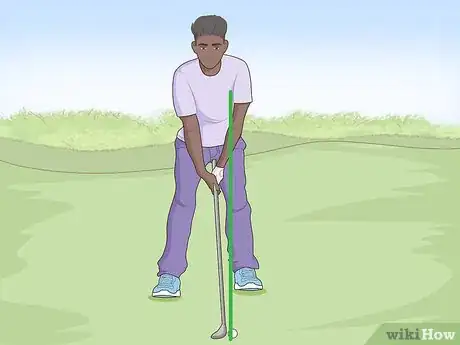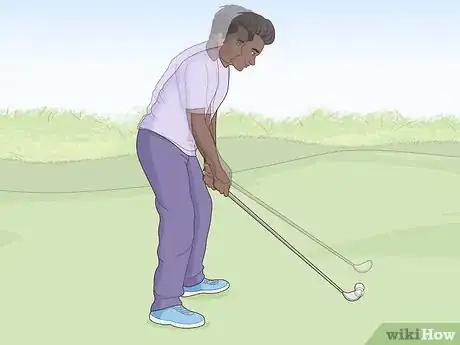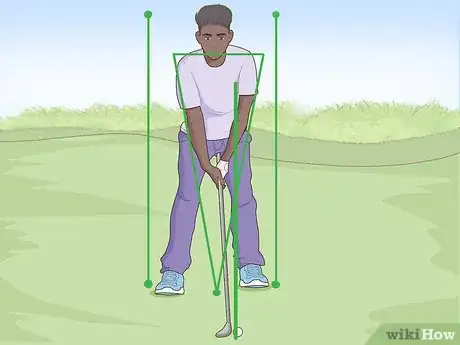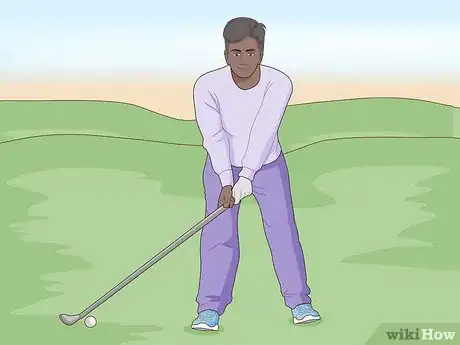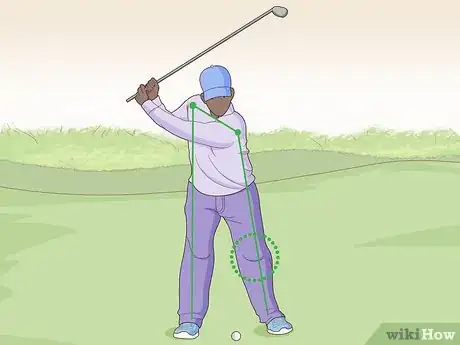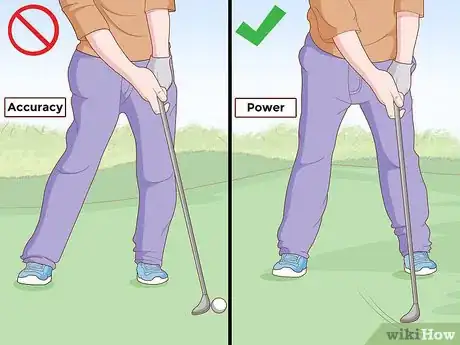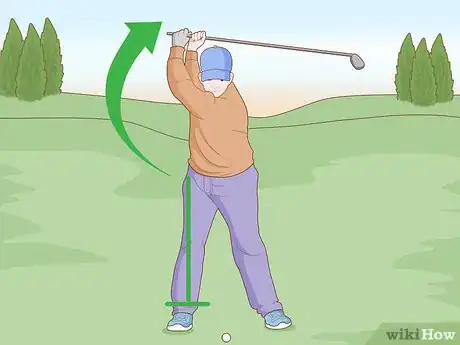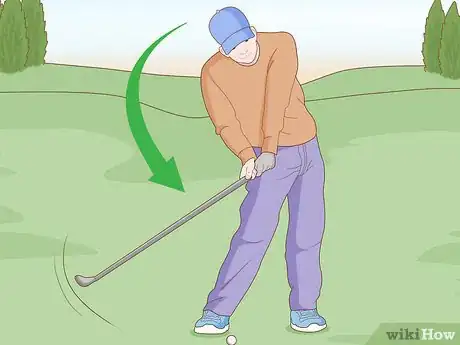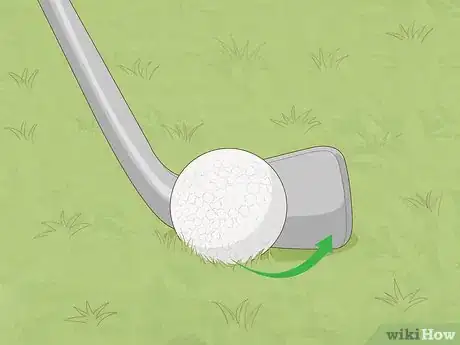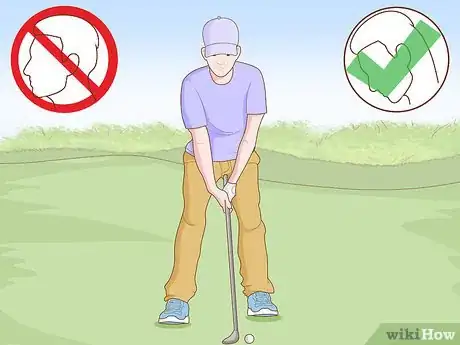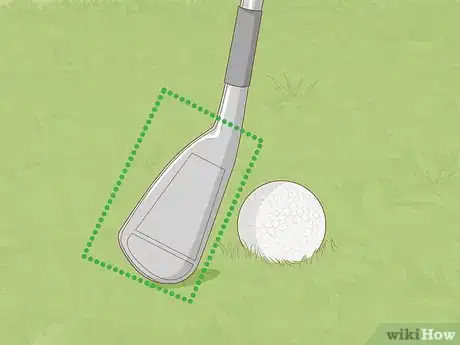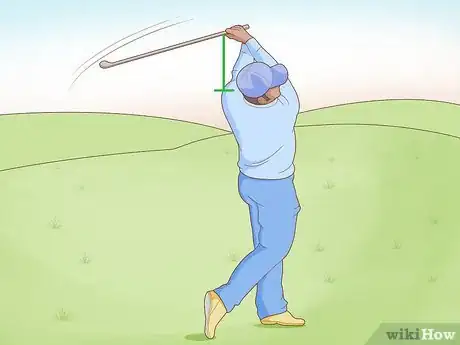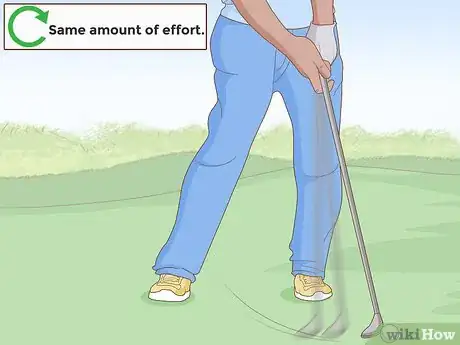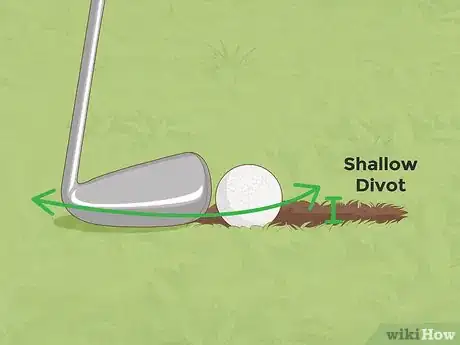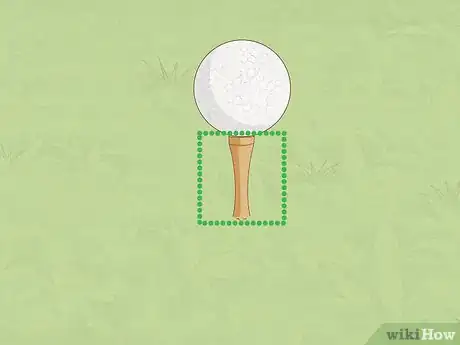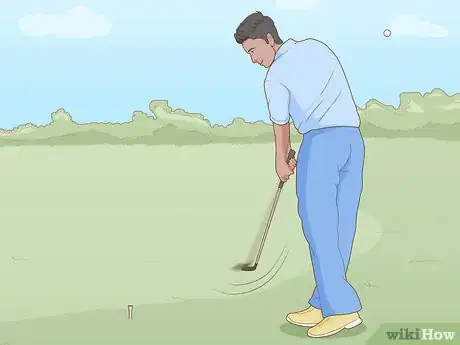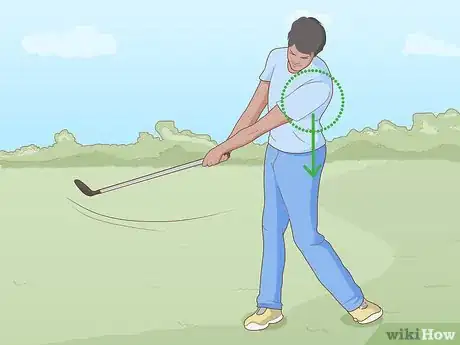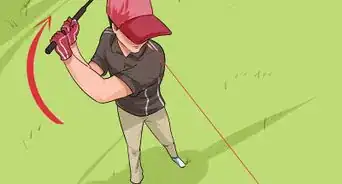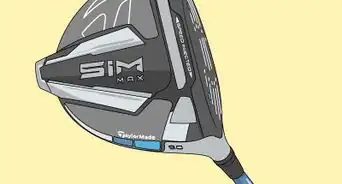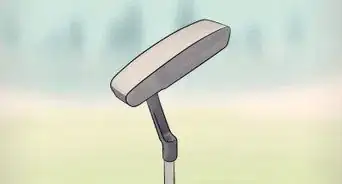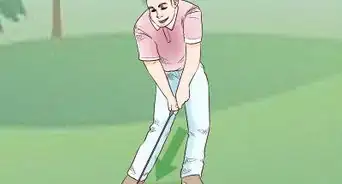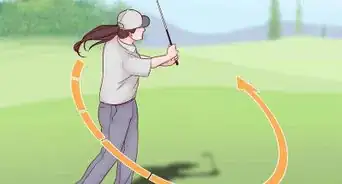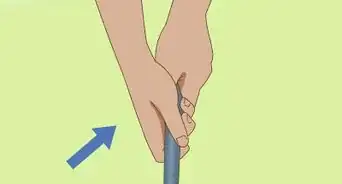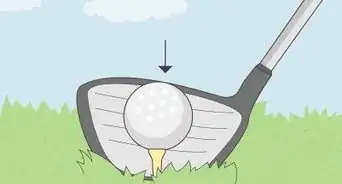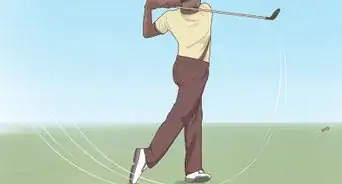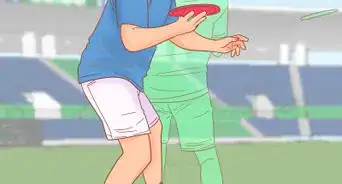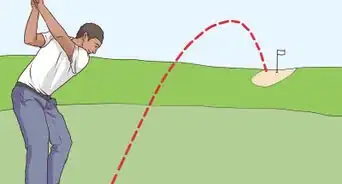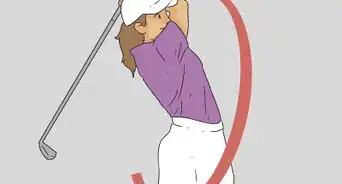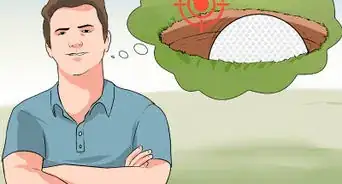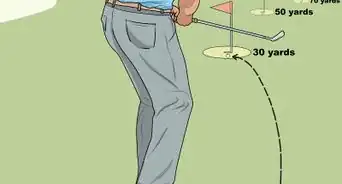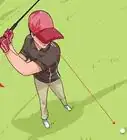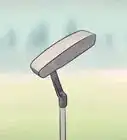This article was co-authored by wikiHow Staff. Our trained team of editors and researchers validate articles for accuracy and comprehensiveness. wikiHow's Content Management Team carefully monitors the work from our editorial staff to ensure that each article is backed by trusted research and meets our high quality standards.
There are 13 references cited in this article, which can be found at the bottom of the page.
This article has been viewed 16,457 times.
Learn more...
The 3 wood is known as one of the hardest shots in golf, but it can be a valuable part of your game. A good shot starts with a strong stance. Aim your shot well and swing your club at a steady tempo to drive the ball with distance and accuracy. At first, hitting with a 3 wood may seem difficult, but your swing will improve the more you practice.
Steps
Choosing Your Position
-
1Stand with the ball left of the center of your body. Stand behind the ball like you’re about to take a swing at it. Line the ball up with the center of your body. Step to the side so the ball aligns with the left edge of your chest. The ball will be slightly ahead of you.[1]
- Use the ball’s size to position it. When it is placed correctly, it will be 1 or 2 ball lengths to the right of your front heel.
-
2Bend forward slightly at the waist while keeping your back flat. Use the same approach for the 3 wood as you use when driving the ball from the tee. While you're behind the ball, bend forward towards it. Do a test swing to make sure you are able to move the club back and forth freely.[2]
- When you’re in doubt about using a 3 wood, remember that it’s not very different from your driver. Keep your swing the same for both clubs to drive the ball farther.
- To prevent your back from coming out of alignment with your hips, raise your shoulders a little. If you feel uncomfortable, adjust your positioning so you get a strong, compact swing.
Advertisement -
3Balance your weight between your feet. Spread your legs about shoulder-width apart so your stance feels strong. The backswing and downswing are both important parts of hitting a 3 wood shot. If your stance isn’t strong and balanced, your swing won’t be smooth and consistent, ruining your shot.[3]
- Take practice swings as needed to check your balance. If the ball flies away from your target, monitor your balance while you swing. Sometimes, fixing a small balance issue leads to big improvements with a 3 wood.
-
4Tilt your body slightly in the direction of the target. Without moving your feet at all, use your hips to tilt to the side. Your back will no longer be perfectly even with your hips. Tilting forward this way changes your swing a little. It enables your club to catch the ball at the proper angle more consistently.
- If you don’t feel comfortable, check your positioning again. You may be leaning too far forward or standing too far back.
- Never lean back, away from the ball. You may think this will help you lift the ball into the air, but it causes you to lose distance and accuracy on your drive.
-
5Bend your knees and keep your shoulders wide. Keep bending your knees until you feel the upper muscles in your legs engage. Lift your shoulders up, spreading them apart as you grip the 3 wood. In the proper position, your body will feel stable but open so you are able to swing the club in a single, uninterrupted motion.[4]
- Note any spots of discomfort. Bending down too far, for instance, tires out your legs and puts pressure on your back. Stand up straighter or move in a little closer to get that powerful base for your swing.
Aiming and Hitting the Ball
-
1Pick a point ahead of you as a target for the ball. The target you choose depends on how far you can hit the ball with a 3 wood. Don’t overestimate your range. You are better off choosing a spot within your maximum range so you aren’t overexerting yourself on your swing. A bad swing means a shorter, more inaccurate drive.[5]
- Focus on accuracy over power. Once you get your swing down, your drives will begin to fly farther.
-
2Start the backswing without straightening your body. Keep yourself tilted forward with your back bent. Shift your weight to your back leg as you bring the club up and over your back shoulder. Raise the club at a steady pace as your body stays firmly planted on the ground, ready to drive the ball forward.[6]
- Leaning back is a sure way to pop the ball into the air instead of driving it a long distance. Maintain your balance to maximize your swing.
-
3Swing the club forward at a steady pace. Your downswing needs to be the same speed as your backswing. Many golfers rush the downswing in an attempt to hit the ball with more power. For maximum power and accuracy, keep your swing consistent at all times.[7]
- When you’re first learning, focus on hitting the ball properly. Increase your club speed after you’re confident about the consistency of your swing.
-
4Aim slightly below the center of the ball. To drive the ball far, hit it squarely, as close to the middle part of the ball as possible. Aiming a tiny bit lower allows you to lift the ball into the air more without sacrificing much distance. Besides this small adjustment, strike the ball like you would when driving it from the tee.[8]
- With a driver, you aim for the center of the ball. A 3 wood club head isn’t as flat as the driver’s head, so it has more “loft.” Loft causes the club to lift the ball higher.
-
5Sweep the club through the ball without lifting the head up. Act like you’re trying to push the ball along the ground, almost like you’re pushing a broom. Shift your weight onto your front foot as you bring the club forward, keeping your swing pace steady. Hit through the ball without shifting the club’s head.[9]
- Many golfers make the mistake of raising the club to lift the ball into the air, leading to short shots that go off-course. To avoid this, hit down into the ball. With a good swing, the loft on the club’s head will put the ball into the air.
-
6Hit the ball with the open face of the club. Always strike the ball with the flat part of the club’s head. The center portion needs to connect with the center of the ball. When this happens, the club lifts the ball with power and accuracy.[10]
- Hitting the ball with any other part of the club results in a poor shot.
-
7Follow through your shot by bringing the club over your shoulders. Don’t stop your swing when you hit the ball. Let your swing continue in its natural arc. Twist your torso around so you face your target. Bring the club over your front shoulder with its head resting behind your back.[11]
- Without a good follow through, your shot loses some power. If your ball veers from where you aimed, make sure you’re bringing the club all the way around naturally. A good follow through is as smooth as the rest of your swing.
Troubleshooting Your Shot
-
1Hit the ball with the same amount of effort every swing. Consistency is key with the 3 wood. You use it the same way as any other club. If your swing changes when you switch clubs, you won’t get a good hit with the 3 wood. When this happens, slow down and take some practice swings.[12]
- Hit with a steady, confident swing like you would with a driver or any other club. Don’t make the mistake of trying to hit harder or lift the ball more. Make every 3 wood drive the same.
-
2Make a shallow divot when hitting the ball to improve your swing. To make a divot, strike the grass with your club. Aim downwards, swinging through the ball without trying to lift the club’s head off of the grass. Your club will kick up a little bit of dirt. Doing this prevents you from raising the club’s head as it makes contact with the ball.[13]
- Some of the top golfers in the world leave behind divots with their 3 woods. As long as you remember to put the grass clod back in place, a divot isn’t a problem.
-
3Place a tee if you have a hard time striking the ball cleanly. A tee helps in some occasions, particularly when you’re in an overgrown part of the fairway. Pick a tee that barely elevates the ball above the grass. Then, swing the 3 wood like you normally would. Using a tee may help reduce the amount of low-flying or bouncing balls you hit with a 3 wood.
- For some golfers, using a tee makes 3 wood shots much easier. For others, using a tee is unnecessary. If you’re comfortable with your swing, hit the ball as it rests on the fairway so the tee doesn’t mess up your timing.
-
4Aim to the left if your ball slices to the right. Practice with the 3 wood first so you know how much your shot flies to the right. Then, adjust your aim accordingly. Reposition yourself beside the ball to hit towards your new target. The amount of adjustment needed varies from golfer to golfer.[14]
- Slices are very common with 3 woods. Many golfers need to aim about 1 ft (0.30 m) to the left in order to get the ball to stay on target. If your ball curves a lot, you most likely have a flaw in your approach, like lifting the club as it hits the ball.
-
5Lower your right shoulder and rotate your grip to reduce slices. Take your normal swinging stance. After lowering your shoulder slightly, grip your club. Hold onto the sides of the grip rather than the top of the club. Position your hands so you are able to see the first 3 knuckles on your left hand.[15]
- This grip may feel stronger than your regular grip. It helps you turn the club’s face as you swing so you hit the ball with the open, flat part.
Things You’ll Need
- Golf ball
- 3 wood
- Tee, optional
References
- ↑ https://www.youtube.com/watch?v=Jbr9ww2ADvI&feature=youtu.be&t=127
- ↑ https://www.youtube.com/watch?v=y8nYG4ha3ys&feature=youtu.be&t=94
- ↑ https://www.youtube.com/watch?v=y8nYG4ha3ys&feature=youtu.be&t=115
- ↑ https://www.youtube.com/watch?v=Jbr9ww2ADvI&feature=youtu.be&t=184
- ↑ https://www.golfdigest.com/story/harmon_gd0806
- ↑ https://www.youtube.com/watch?v=y8nYG4ha3ys&feature=youtu.be&t=184
- ↑ http://www.golfsamurai.net/fault-fix/how-to-hit-3wood.htm
- ↑ https://www.youtube.com/watch?v=UZvIcgTYiBk&feature=youtu.be&t=70
- ↑ https://www.golfdigest.com/story/tigertips_gd0706
- ↑ https://www.youtube.com/watch?v=dw8mMH7Cr4Q&feature=youtu.be&t=165
- ↑ https://www.golf.com/video/the-coolest-shot-kevin-chappell-can-hit
- ↑ https://www.golfdigest.com/story/best-teachers-sean-foley
- ↑ http://www.golfsamurai.net/fault-fix/how-to-hit-3wood.htm
- ↑ http://www.golfsamurai.net/fault-fix/how-to-hit-3wood.htm
- ↑ https://www.youtube.com/watch?v=wlAz6PL8abs&feature=youtu.be&t=245
- ↑ https://www.golfdigest.com/story/harmon_gd0806
